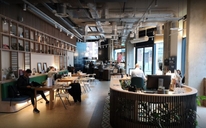Hybrid working is no longer a trend it’s a permanent shift in how modern businesses operate. As teams split their time between the office and home, many companies are rethinking their office strategies to support productivity, collaboration, and employee well-being. But here’s the critical question: is your current office setup really supporting your hybrid workforce?
In this blog, we’ll explore the key elements of a hybrid-ready workspace, the common pitfalls to avoid, and practical steps to make your office work better for your evolving team.
What is Hybrid Working – Really?
Hybrid working blends remote and in-office work, giving employees flexibility while still offering a physical hub for collaboration, culture, and connection. There’s no one-size-fits-all approach some companies have fixed days for in-office work; others leave it entirely to employee preference.
The best hybrid strategies balance flexibility with structure, freedom with purpose. And the physical workspace plays a critical role in making it work.
Signs Your Current Office Setup Isn’t Hybrid-Friendly
Here are some red flags that your office might be falling short for a hybrid team:
- Desks are rarely full, but meeting rooms are always booked.
This imbalance suggests your layout prioritises outdated working patterns rather than flexible collaboration. - Employees complain about a lack of focus space or quiet zones.
Hybrid teams often come to the office for deep work if your setup is too open or noisy, it can drive them away. - Tech issues with hybrid meetings are a daily headache.
Without seamless video conferencing tools and good acoustics, collaboration suffers. - You’re paying for space that’s barely used.
If desks sit empty for days at a time, it’s time to re-evaluate your layout and lease.
Key Features of a Hybrid-Optimised Office
To truly support a hybrid workforce, your office needs to work smarter not just harder. Here are the key elements of a successful hybrid workspace:
1. Flexible Layouts
Design your space for movement and adaptability. That means:
- Hot-desking areas instead of assigned seating
- Breakout zones for informal collaboration
- Private booths or quiet rooms for focused work
- Moveable furniture and modular layouts
This creates a “use what you need” approach that maximises value and supports different work styles.
2. Technology That Works (Seamlessly)
Hybrid meetings are now the norm, so your tech needs to keep up:
- High-quality video conferencing systems
- Reliable Wi-Fi throughout the space
- Acoustic treatments to minimise echo and noise
- Booking systems for desks and meeting rooms
Don’t underestimate the frustration of dodgy connections or screen-sharing mishaps it can erode morale and productivity.
3. Collaboration Hubs
When people do come into the office, it’s often to connect with colleagues. Give them a reason to come in:
- Creative breakout spaces
- Team pods with whiteboards
- Informal lounge areas
- Café-style seating for impromptu chats
The office should feel like the social, collaborative hub of the business not just a place to sit in silence.
4. Focus and Wellness Spaces
Balance is key. Your hybrid team needs space for deep work, too:
- Quiet pods or single-person booths
- Natural light and plants for mood and focus
- On-site wellness rooms or relaxation areas
You’re not just designing for function you’re designing for experience.
Is It Time to Rethink Your Space?
The pandemic prompted a rapid shift in workplace expectations. Today, the challenge is building office environments that reflect that change.
Ask yourself:
- How often is our space really used?
- What do our employees value most when they come in?
- Are we spending money on space that isn’t fit for purpose?
- Do we have the flexibility to scale up or down?
If the answers raise more concerns than confidence, it might be time to consider a new type of workspace like flexible offices.
The Flex Office Advantage for Hybrid Teams
Flexible office spaces are designed with hybrid working in mind. They provide:
- Shorter lease terms (with the ability to scale)
- Access to high-quality shared amenities
- Fully-fitted meeting rooms and breakout zones
- Smart layouts that accommodate fluctuating headcounts
- Concierge support, cleaning, and services included
Whether you’re a start-up, scale-up, or an established company looking to adapt, a flex space can offer the agility and cost-efficiency hybrid working demands.
Final Thoughts: Office Space That Works As Hard As You Do
Hybrid working is here to stay and your office needs to keep up. A workspace that feels empty, outdated, or rigid can undermine your hybrid strategy and affect team performance.
Instead, aim for a flexible, tech-ready, people-first environment that empowers your team no matter where they’re working from.
If you’re wondering whether your current space is holding you back, we’re here to help.
Thinking of reconfiguring or relocating your office to support hybrid work?
At Flex Office Solutions, we specialise in finding spaces that match the way your team works today and tomorrow. Get in touch for expert, friendly advice and a free shortlist of options tailored to your needs.




